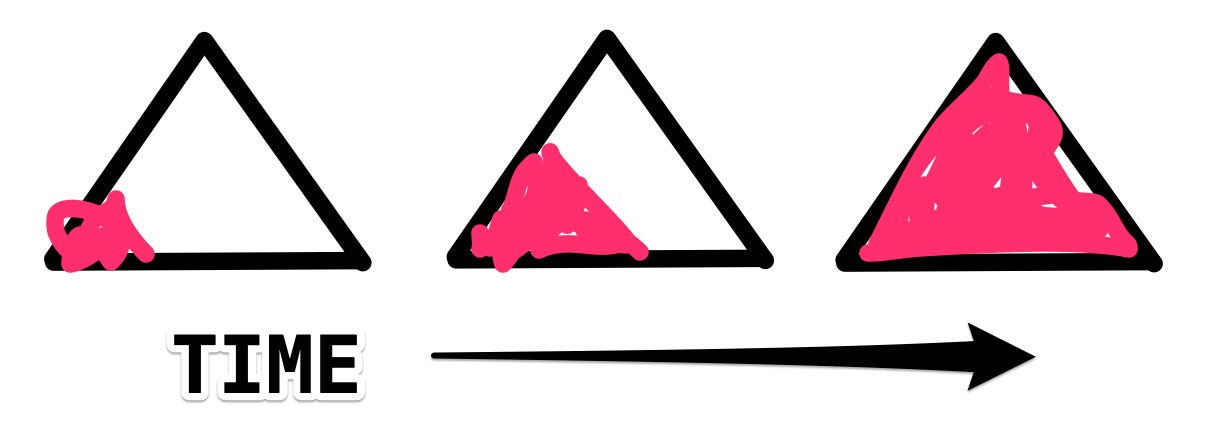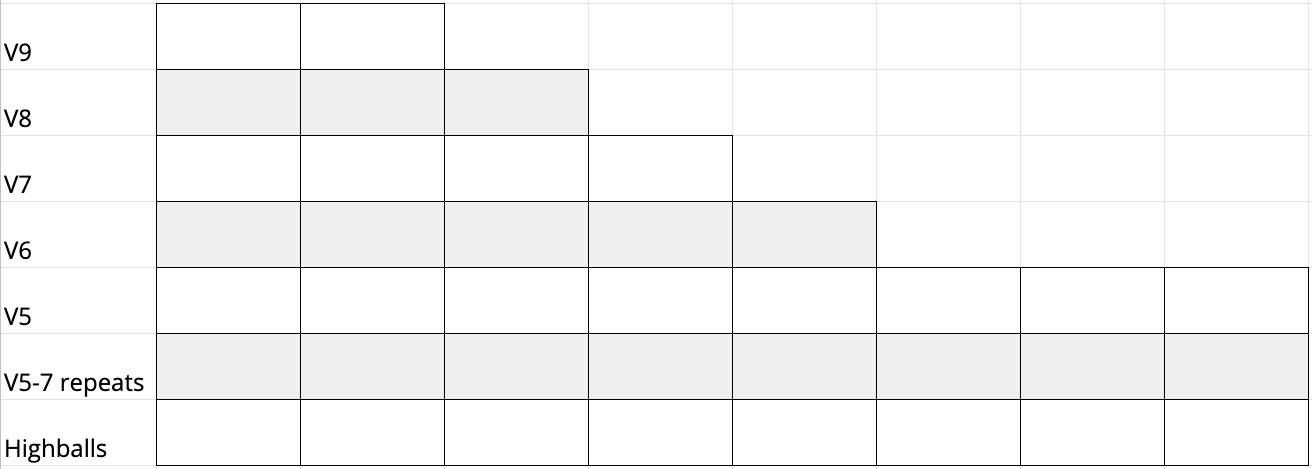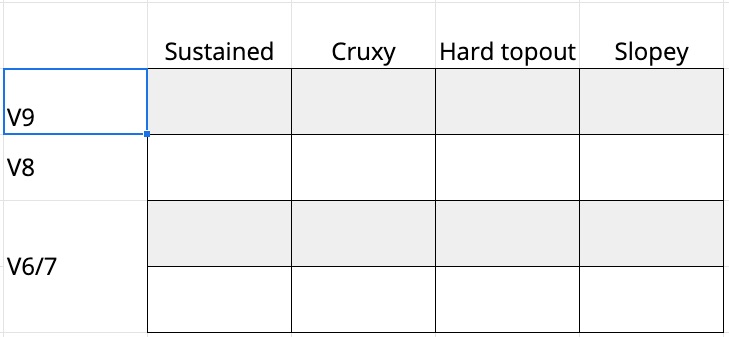Many climbers use pyramids each season, mesocycle or macrocycle to have a tangible representation of the growing confidence and momentum that they build through that period.
Online logbooks like 8a.nu, Sendage and Kaya all provide a pyramid in their interface. This is one reason I recommend all motivated outdoor climbers keep some kind of logbook, because it makes seeing your lifetime pyramid easy! Seeing it visualized can help you feel confident and proud of your climbing.

Pyramids, when constructed right, are SMART goals – Specific, Measurable, Attainable, Relevant, Timely. Identifying with our goals is important to reaching them, and it’s easier to identify with something you can see. For this reason, I recommend everyone put their pyramid somewhere physically obvious, like on the fridge. (While you’re at it, put a photo of your big goal route there, too.)
Building a base helps improve your physical capacity. But more importantly, it means improving your confidence and your sending inertia. Sending is, itself, a skill. You know that one friend who isn’t the strongest, but seems to send something every time they go out? They have this habit down. Sending boulders and routes is a habit. Forcing yourself to fill in your pyramid forces you to work on that habit.
There are tertiary benefits, too: filling out your pyramid forces you to get outside even when you might not. It makes you go visit boulders and routes you’ve overlooked, to fill out the margins of your base. You might learn a new move, see something you otherwise would have missed, or make a new friend.
Ideas for making a pyramid
Your pyramid should not be too big. Look at past seasons/years and see how much you sent. A is for Attainable, remember? If you wind up doing more than you expected, your pyramid can always have a porch or a sundeck hanging off the side.
As far as how many climbs to use in each sub-tier, it depends on what climbing is available to you, how motivated you are, conditions, and lots of other factors. Start humble and adjust your pyramid for each season as you dial it in. (There are some sample pyramids further down the page.)
Target the peak at your main goal. If you haven’t picked one for the season, that’s fine – you should know roughly where it is. Remember, the rest of the base will help no matter where your climbing is going a year or 5 from now. What matters is continuing to develop your skills.
Pre-fill routes that you consider “must-do” for the season. This works best for lower tier climbs that you’re confident you can accomplish.
Use your base tiers to develop weak areas. If you’re struggling with mantels, set aside a few of your lowest tier for problems with hard topouts. If your main goal for the season is a blunt arete, maybe try to seek out a few blunt aretes to fill in your base.
Seek out new skills and use them to fill in your pyramid. Think, “what do I want to learn in climbing?” and then put a little mini-pyramid inside your pyramid. If your max goal is 13a but you want to work on runouts, you could do a mini-pyramid of a few 12as and a 12b that are a bit runout.
When I sent one of my favorite highballs, I spent several days practicing my top-rope solo setup with new gear so I could rehearse the top moves without stopping to pull in slack. While it was helpful for sending my project, more importantly I learned a new skill that I can use in the future!
Group base grades together. Don’t take the grades too seriously. At a certain point it doesn’t really matter if a climb is 10d or 11a. (Half the time, 10d is harder than 11a anyway.) If you’re shooting for 12a, just focus on getting a base of climbs from 10c to 11a.
Forget about grades for certain skills. If you’re a boulderer, learning how to climb off the deck in risky situations can be an important skill. Even a V8 boulderer can get something out of a V2 highball. Including a “highball” tier at the base for boulder pyramid, or a “gear leads” tier at the base of a sport pyramid are great ways to add variety and still feel like you’re building your base.
Repeat climbs from previous seasons. I usually reserve a tier for “re-points.” I lump a bunch of grades into the same category, because often you can send something faster when you come back to it. This can make finding partners easier, and motivate you to try hard to repeat something! I usually don’t re-point within a grade or two of my target, though, unless it’s an extension or variation of my project.
Consolidate at a grade by using a skill grid, rather than a pyramid. If you climb during your off-season, spend all year on the road, or have a ton of local climbing, this option might be for you. Rather than building towards a target grade, work on skills you want to develop or types of climbs you want to send. See further down the page for examples.
Give it a time limit, but don’t stress it. There’s no need to start your pyramid over unless you take a significant break from all climbing, like due to an injury or big life change. (It’s fine to start over if you just feel your motivation waning, of course.) Most pyramids are good for a season or a year.
Ideas for filling out your pyramid
It’s pretty easy: just look at your pyramid every day, and let it influence what you want to go try with your time. At first, you should feel like you have a lot to do! That’s good, because it will motivate you to get a few ticks to get started.
How much time to spend on each tier will become more obvious during the season. If you’re just starting out, then obviously start at the bottom. Usually the pyramid will fill in upwards diagonally, like so:

Of course, the unspoken story is how much time each tier of the pyramid takes to actually accomplish. The one brick at the top might take ten sessions, while the ten bricks in the base took a session each. So you do need to plan on spending time proportionally. I suggest something like 70/30 base/project climbing at the start of the season, slowly ramping up to more like 30/70, with a proportionate increase in rest days.

When the season or macrocycle is over, I recommend spending some time doing unstructured climbing. Especially if you achieved your goals but still have a bit of time/fitness left in your performance phase, it can be a great time to get out and explore. Do some onsighting, or the remote multipitch you always wanted to do. Check out the roof boulder you wanted to try but were afraid it would eat up too much of your recovery volume.
Sample pyramids for bouldering
These are just ideas to get you started. I don’t recommend using one of these pyramids literally, unless it fits your situation. Use them as a jumping off point. You can view the google sheet they all came from here. Go to File > Download > as PDF and select “Current Sheet” to get a fairly good printable version.
Boulder pyramid to goal of V5 for a season. This is probably for a climber who has did several 4s, or maybe a 5, last year. They feel confident & ready to get work done at the V5 grade, and might even have picked a few out.

Boulder pyramid to goal of V9 w/ highball tier. This assumes a lot of time & access to climbing, over a few seasons. For a long-term pyramid, there will probably be a recovery & preparation phase in the middle. The pyramid continues percolating in the background. This would be a climber who is confident at the V7/8 grade, and is probably thinking long-term towards building a base for V10.

Boulder pyramid to goal of V11, for an entire year. This is my pyramid right now. I’ve sent V12, but I would like to consolidate at V11, so my goal grade has 3 spots. This will help set me up to level up next year. I have lots of access to climbs, and travel a lot for climbing, so it’s a big pyramid.

A climber aiming for V9, with access to a Moonboard, might make a pyramid like this. (The grades here would be hugely dependent on how good you are at board climbing!) This gives you something to work towards, even if you’re limited by conditions or time. However, the Moon sends still can’t fill the entire pyramid. You do still need to go on trips, or get outside. Otherwise you might as well have an entire pyramid of Moonboard climbs – which would be fine, too, if that’s what you’re into.

Boulder skill grid. This is a more advanced technique. Let’s say a climber is preparing to try a V11 in fall. It has a really hard first move, but then stays sustained. Most of the holds are sloping and the topout is full-value. A good spring or summer boulder grid would look like the below, seeking out various climbs of each facet. This requires access to a lot of climbing, and spending some time combing through the guidebook to find the right problems. I would probably transition these climbs into a bigger pyramid come fall, or fill out both the grid and pyramid concurrently.

Sample pyramids for sport climbing
A basic route pyramid for a climber looking to do their first 12a.

Here’s a route pyramid for a climber aiming for more like 12c. In this case they do some trad climbing at the end of summer, just before conditions start getting good. Those efforts definitely count towards your base, and should be included in the pyramid.

Here’s a more advanced route grid for a climber trying to do 13b. 12d and 13a are doubled up because they’re often interchangeably difficult. Advanded sport climbers tend to repeat a lot of the same climbs as warmups, so there’s lots of space for re-points in the pyramid. Truly prodigious climbers could even require themselves to double or triple send their volume climbs before considering them re-pointed. (The old “masterpoint” rule required three sends.)

Here’s what that pyramid might look like, pre-filled. There’s room for new things and unexpected inspiration, but the targets for the season are selected. Some routes hover outside the grid as stretch goals. Re-points necessary for building fitness or confidence are also pre-filled.

Make your own pyramid
Here’s the spreadsheet where these samples live. View it, make a copy and edit it to your needs!